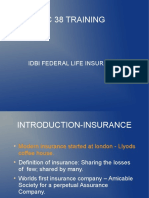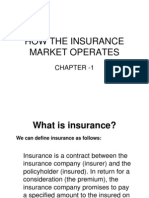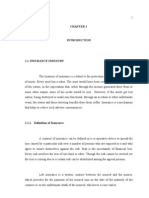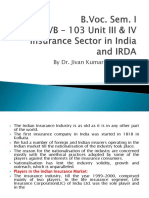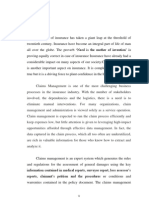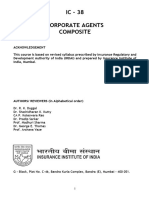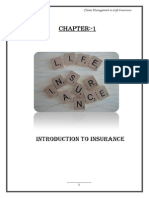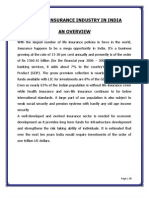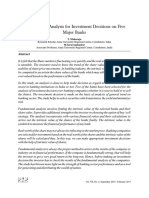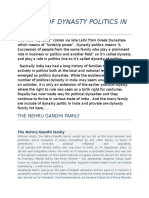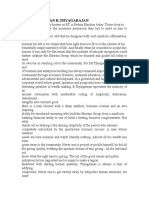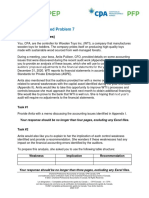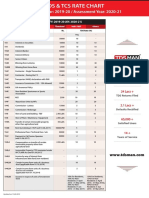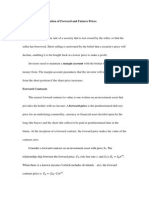Chapter - 1: Insurance Certification Examination Notes
Uploaded by
Shikha ShuklaChapter - 1: Insurance Certification Examination Notes
Uploaded by
Shikha ShuklaInsurance Certification Examination Notes
Chapter - 1
What is insurance?
Insurance is a contract between the insurance company (insurer) and the
policyholder (insured), in return for a consideration (the Premium), the insurance
company promises to pay a specified amount to the insured on the happening of a
specific event.
How does Insurance work?
Risk Retention Not very wise way of handling Risk.
Risk Transfer Transfer the risk from one person who does not have the capacity to
bear them to someone who does have the capacity for them, is known as Insurance.
Thus, Insurance is nothing but a risk transfer mechanism, it protect the economic
value of assets.
Role of Financial services and insurance
Social If a family that loses its income provider they will depend on the income of
their relatives for their living expenses and other financial goals. Insurance provides a
security against these dependencies.
Economically
1. Its provides Employment (Direct and Indirect both)
2. Provide Loan to Government (through Bonds, especially in traditional plans)
3. Invest in the various infrastructure project (through debenture of private
companies)
Insurance benefits society as a whole, not just those who hold insurance.
Some of the benefits for a policyholder are:
1. Investment option (Equity & Debt both)
2. Protection of financial security
3. Tax benefits
4. Planning for life stage needs
5. Loan against insurance policy (though Insurance company and Banks)
Benefits of a professional insurance market
Need based selling
Stop Mis-selling
Disclosure (Complete disclosure about the product, breakup of premium, commission
etc.)
Benefits of professional Insurance Markets
1. Higher confidence among the policyholders
2. Increase in insurance penetration
3. Social Benefits
4. Employment generation
5. Increase in profits for the insurance company.
History of Insurance
1. Phase I Pre-Liberalization (1818-1993)
2. Phase II Liberalization (1993-1999)
3. Phase III Post- Liberalization (1999 onwards)
Pre-Liberalization:
Key Point:
First Insurance company-1818, The Oriental Life Insurance Company at Kolkata
1
Prepared by Deepak Singh,CFPCM-Trainer
Email id: deepaksinghcfp@gmail.com; #: 9999488044
Insurance Certification Examination Notes
First Regulation The Indian Life Assurance Companies Act 1912
Insurance Act 1938
1956 Government nationalized 254 private, foreign companies and provident society
and passed LIC Act 1956 and give LIC the only power to do Life Insurance business in
India.
1972 Formation of General Insurance Council
1972 The General Insurance Business (Nationalisation) Act 1972 (GIBNA) was passed.
The General Insurance Corporation of India (GIC) was formed under the company Act
1956 as a private company limited by shares.
Liberalization: Under this phase the Government was started reforms:
Key Point:
Malhotra Committee (1993) In 1999 the government has formed Malhotra
committee under the chairmanship of Mr. R. N. Malhotra to make recommendation for
the reform of the Insurance sector. On the basis of his report given in 1994, the
government open the life insurance sectors for the private and foreign insurance
companies.
1999 Formation of IRDA as an autonomous body to regulate the development of
Insurance industry. The IRDA was incorporated as a statutory body in April 2000.
Post- Liberalization (1999 onwards):
Key Point:
The government permitted the foreign companies to do life insurance business in India
but only through a joint venture with an Indian company.
FDI LIMIT 26%
W.e.f. 21st March 2003 GIC ceased the power of as a holding company of his
four subsidiaries. The ownership vested with the government of India. GIC was
notified as a reinsurance company for Non Life Insurance.
Recent Development in the Insurance Industry.
Growing importance of IT
Bancassurance
Online Sales
Micro-Insurance
Grievance Redressal The customer can either call a toll-free number 155255
or email complaints@irda.gov.in to register their complaint.
Micro-Insurance Plans:
Provides cover to low income groups.
Minimum Sum Assured is Rs. 5000 and Maximum is Rs. 50000
Premium Mode - Weekly
Cross selling is allowed of micro insurance product by life insurer and non life insurer
Types of Insurance Organisations
Life Insurance Company
Non Life Insurance Company
Reinsurance
Role in the Insurance Industry / Constituents of the insurance markets:
1. Agents (Individual Agents)
6. Third Party Administrators (TPAs)
2. Corporate Agent
7. Loss Adjusters/Surveyors
3. Intermediaries (Brokers)
8. The Regulator (IRDA)
4. Underwriters
9. Training Institutes
5. Actuaries
10. NGOs
2
Prepared by Deepak Singh,CFPCM-Trainer
Email id: deepaksinghcfp@gmail.com; #: 9999488044
Insurance Certification Examination Notes
Actuaries: They calculate the standard price of the product (designed the products) and also
do the annual valuation of the company to know the solvency of the company and declare
bonuses.
Training Institutes: Insurance Institute of India, National Insurance Academy (NIA), and
Insurance Institute of Risk Management (IIRM)
NGOs: Promoting the customers rights. Linking buyer and seller, spreading awareness
about insurance products.
Insurance Distribution:
Direct Marketing Channels
E-Sales (Online Sales)
Indirect Marketing Channels
Bancassurance
Comparison websites (like policybazar.com etc.)
Role and Functions of an agent:
Becoming an agent: The Insurance Act 1938 requires that an agent must have a license.
Role of an Agent:
Act as the main link between the insurance company and the insured.
To recommend the right products that addresses the clients needs.
Act in the interest of the Insurance Company.
Facilitate the smooth sale of insurance products.
Service the client properly unity maturity or in the event of a claim.
Code of conduct for an agent:
Specified by the IRDA in the IRDA (Licensing of Insurance Agents) Regulation
2000
Should disclose all information about the Company and the Products
Act in the interest of the client and Company both.
Chapter - 2
Risk and Insurance:
Concept of Risk:
Definition: The Risk can be defined in three different ways:
1. Risk is the chance of damage or loss.
2. Risk is doubt concerning the outcome of a situation
3. Risk is something or someone considered to be a potential hazard.
In Life Insurance risk is used to describe the possibility of an unfavourable event
occurring, e.g. untimely death, or an unforeseen disability.
Risk to human life:
Illness
Premature Death
Accidents
Unemployment
Living to long beyond retirement
Prepared by Deepak Singh,CFPCM-Trainer
Email id: deepaksinghcfp@gmail.com; #: 9999488044
Insurance Certification Examination Notes
Components of Risk:
Uncertainty
Level ( Probability or Frequency, Extent or severity)
Peril and hazard
Life Insurance companies determine the level of risk based on past data (claim experience).
The past data indicates that individuals within a certain age group (say 60-70) are more prone
to heart attacks then the level of risk will be considered to be higher for that age group.
Peril and Hazard
Peril: Peril refers to a specific event which might cause a loss. Peril is the risk being
insured against.
Hazard: Hazard is a condition that either increases the chance that a peril will happen
or might cause that it effect to be worsen if it does.
(e.g. Lung cancer is a peril and smoking can be a Hazard.)
Type of Hazards:
Physical Hazards
Moral Hazards
Physical hazard:- Physical hazard refer to the physical characteristics of the risk associated
with the life insured. E.g.
Age, Occupation, Gender, Residence, Habits, Height and weight
Hobbies, Physical characteristics, Medical condition
Physical handicap, Medical history of the family, Personal history
Moral hazard:- More difficult to define because it relates to the conduct and/or intention of
the proposer. Such as:
Reckless or careless attitude to health and personal safety
Previous history of dishonesty
Previous claim history if it reveals a history of fraudulent/frequent claim, bankruptcy or
financial difficulties.
Fraud and Moral Hazard: The following are some example: Requesting large amount of insurance at the later stage of their lifecycle
Insurance taken by an individual with no dependants
Insuring a non-earning member of the family
When the nominee of the policy is not among the dependants of the insured
Past premium payments of the individual are much higher than they are capable of
paying.
When the medical check-up is carried out at a different place from the place of
insurance.
If the relationship of the agent and the proposer causes the underwriter concern.
Some of the hazards that would cause an individual to be categorised as high risk
are:
Risky job profile
Existing medical conditions
Lifestyle of an Individual
Age group of the individual
High risk proposals can be accepted on other than standard terms such as charging a higher
premium imposing restrictions on the sum insured, term or a lien etc.
Insurable Risks:
4
Prepared by Deepak Singh,CFPCM-Trainer
Email id: deepaksinghcfp@gmail.com; #: 9999488044
Insurance Certification Examination Notes
Financial Risks : Loss of Life, Disease or disability, Retirement, Savings accumulation
Pure Risks: Those risk where there is no possibility of making a profit. There can be a
loss and the best possible outcome is one of breaking even.
Particular Risks: Those risk that are personal or local in their effect.
Pooling of Risk: Insurance company pools the premium collected from several individuals to
insure them against similar risks. The insurance company maintains different sets of pools for
different risks e.g. Life Insurance, Care Insurance, Home Insurance, Travel Insurance etc.
The premium that is charged should be sufficient to meet:
The administrative expense
Other expenses for maintaining the pool
A certain percentage of the profit.
Law of large numbers.
Insurance companies apply the law of large numbers to determine the cost of total
annual claims. An insurance company will set the rates of its premiums according to the
number of claims it will expect to pay over the term of the policies.
Chapter 3
Part 1. Insurance Principles:
Essentials of Valid Contract of Insurance:
An Insurance contract is an agreement enforceable by law, between the Insurance company
and the Insured person.
Features of a valid contract:
Offer and acceptance (Counter Offer)
Consideration
Capacity to contract: (a. Age of majority, B. Sound Mind, C. Not disqualified by law,
from entering into contacts.)
Consensus ad idem (This means both the parties must understand and agree upon
the same thing, in the same sense. )
Legality of object or purpose
Capacity of Performance: The contract must be capable of being performed by both
the parties. e.g. A person requesting life insurance for a very high amount should be
capable of paying the premium required.
The Policy Document:
The policy document is not the contract of insurance in itself; rather, it is evidence of
the contract.
Utmost Good Faith:
A positive duty voluntarily to disclose, accurately and fully, all facts material to the risk being
proposed, whether requested or not.
Breach of the duty of utmost good faith:
1. Non-disclosure: or the omission to disclose a material fact, either inadvertently or
because the proposer thought it was immaterial.
2. Concealment
3. Fraudulent Misrepresentation (e.g. a person declares his age to be five year less
than he actually is)
4. Innocent misinterpretation ( inaccurate statements which are believed to be true)
5
Prepared by Deepak Singh,CFPCM-Trainer
Email id: deepaksinghcfp@gmail.com; #: 9999488044
Insurance Certification Examination Notes
Duty of disclosure: Applies on both Insurer and Insured
Insureds duty of disclosure:
It is important that the proposer makes full and complete disclosure of all the material facts
relating to the contract (e.g. facts, relating to their health, lifestyle (alcohol, tobacco), Denial
of Insurance in past by any company or acceptance of proposal in the past at a higher
premium than normal)
The duty of disclosure is revived at each renewal stage.
Insurers duty of disclosure:
The insurer also has a duty of disclosure to the insured:
Insurer should make sure that it discloses all information related to the insurance
product in all its literatures.
In health Insurance at the time of renewal some companies offer a discount on the
premium or increase the cover by a certain percentage keeping the premium the same,
if there is no claim made by the insured in the same year.
They charge lower premium from a non-smoker compare to those are smokers.
Material Facts: Material facts help the underwriter to decide two things:
Whether to accept the risk proposal or to reject it
If the proposal is to be accepted, then at what price (premium) it should be accepted.
Consequences of non-disclosure
The insurer may avoid the contract entirely, ab initio (from beginning), no claim are
payble.
If the non disclosure is fraudulent (concealment) the insurer may keep the premium
also.
Life Insurance (Duty of disclosure when operates)
At the time of proposal up until the time the risk is accepted by the insurance company
and FPR is being issued.
In the event that a lapsed policy is revived.
Insurable Interest:
When an individual stands to gain or benefits from the continued existence or wellbeing of another individual(s) or property.
At the same time the individual would suffer a financial loss or inconvenience if
there is damage to the other individual(s) or property.
Insurable interest is not defined by any law; it can be decide on the basis of:
A, Interest B. Relationship
C. Legal Decision (Court Judgements)
Circumstances in which insurable interest exists:
1. Own Life (Unlimited)
6. Surety (up-to Guarantee Amount)
2. Spouse
7. Employee-Employer (One month of
Salary)
3. Children
8. Employer-Employee (up-to the amt of
services provided)
4. Assets
9.Keyman Insurance
5. Creditor (up-to Loan Amount)
10. Partners
Insurable Interest need to be exists:
In Life Insurance - At the time of Inception of the Policy (need not to be proved at the time
of claim)
Non Life Insurance
- Both, at the time of Inception of the Policy and at the time of Claim
6
Prepared by Deepak Singh,CFPCM-Trainer
Email id: deepaksinghcfp@gmail.com; #: 9999488044
Insurance Certification Examination Notes
Marine Insurance- Only at the time of Claim (In Marine Insurance Insurable interest operates
in different way
in compare to Life and Non- Life Insurance).
Indisputability clause (Section 45)
In first two year of policy insurance company can declare the policy null and void if the
company comes to know that some material fact has not been disclosed.
After tow year, fraud must be established by the insurance company if it wishes to
make the policy void.
This clause applies to life insurance only.
Indemnity:
It is a financial compensation sufficient to place the insured in the same financial
position after a loss as they enjoyed immediately before the loss occurred.
Insurance company only compensate the insured for the loss they incurred.
This principle ensures that insurance cannot be used to make profit.
Life Insurance contract is a VALUE contact, hence Principle of
indemnity dont apply on L.I. contract.
Part 2: Insurance Principles
Sources of preliminary information: - Through Mass media advertisements.
Purpose of buying Insurance: - The purpose is based on the need of an individual or nonindividual.
How life insurance is written
On Single Life basis / Own Life Policy, or
Joint life Policy (Husband & Wife or Business partners)
Proposal Form
Proposal form is the basis of the contract
Proposer will fill the proposal form and submit it to the insurance company, It contains
informations like: Name, Age, Address, Weight, Height, Medical history, Type of
Insurance plan, Nomination, Riders, details of earlier insurance plans etc.
Quotation / Illustration / B.I. Document:
It disclose how much policy will cost and on what terms.
It will often be held open for a set period.
It also shows how much the fund will grow at 6% and 10%
Key Documents
1. Proposal form
2. Age proof
3. Premium receipts
4. Policy document
5. Endorsements
6. Notices
7. Prospectus (Brouchers)
8. Documents required during claim
Declaration in the proposal form:
By signing a declaration, the proposer declares that the information they have provided in the
form is correct and:
The insurance company can cancel the contract and keep the premiums if it finds out
that any of the information provided is not true.
Prepared by Deepak Singh,CFPCM-Trainer
Email id: deepaksinghcfp@gmail.com; #: 9999488044
Insurance Certification Examination Notes
They understood the questions, they cannot claim that they were given wrong
information or misled in any way.
If proposer is illiterate, then an impression of the left thumb is taken and a third
party has to attest the same and the third party have to declare that they have
fully explained the questions to the proposer and they have correctly entered the
answers after consulting the proposer. In this case the address of the declaring person
may also be taken.
If the proposer signs the declaration in a different language from the proposal
form, then the proposer has to declare, in their own handwriting above their signature,
that all the questions were explained to them and that they answered them only after
fully understanding them.
Age Proof
Standard Age Proof Documents
1.
2.
3.
4.
5.
6.
7.
Certificate from school or college record
Municipal Date of Birth Record
Passport
PAN Card
The service register of the employer
A certificate of baptism
A certificate extract from a family bible, is
contains DOB.
8. ID card of defence personnel
9. Marriage certificates issued by the Roman
Catholic Church
Non Standard Age Proof
Documents
1. Horoscope prepared at the time
of birth
2. A ration card
3. An affidavit by way of self
declaration, elders declaration
4. A certificate from a village
panchayat
Premium Receipt:
First Premium Receipts (FPR)
When the insurer accepts the proposal and starts the risk cover he adjust the premium that is
paid by the proposer is adjusted in the office and issue FPR.
The FPR is the evidence that the insurance contract has begun
Insurance Contract commences from the date on which insurance company issue FPR
The policy document may be issued some time later.
The FPR contains following informations:
Name and address of the life insured
Policy number
Premium amount paid
Method and frequency of premium payment
Next date that the premium payment is due
Date of commencement of risk
Date the policy matures
Date the last premium will be paid
Sum insure
Renewal: (Renewal Premium receipts (RPR))
Life insurance policies are long term policies, running for a set period of often many
year.
General insurance policies on the other hand, issued for one year and renewed every
year.
IRDA regulation requires that the decision on proposal has to be passed to the
proposer within 15 days.
8
Prepared by Deepak Singh,CFPCM-Trainer
Email id: deepaksinghcfp@gmail.com; #: 9999488044
Insurance Certification Examination Notes
Free look-in-period or Cooling-off period:
The policyholder has the right to withdraw from the contract within a period of 15days
from the date of receipt of the policy document if they disagree with the terms and
condition of the policy. This period is known as free look-in period.
The Insurance company will return the premium after some deduction:
1. Stamp duty
2. Cost of covering the risk for the short period
3. Medical examination expenses, if any.
Policy Document (An evidence of the contract between the Insurer and Insured)
A standard policy has the following section:
Heading (Contains name, address and logo of the company)
Preamble- (This section states that the proposal and declaration signed by the
proposer
Operative Clause- This section lays down the mutual obligation of the parties
regarding
The payment of premiums by the insured, and
The payment of the sum insured by the insurer on the happening of the
insured event
Proviso- States the general provision relating to guaranteed surrender value,
nomination, assignment and loan on security of the policy etc.
Schedule: gives all the essential particulars of the policy, such as:
Date of commencement of policy;
The date of the policy matures;
The sum insured (when and how much the policy will pay);
The premium to be paid and their due dates;
The nominee (if stated in the proposal form)
Any special clauses, Details of riders, exclusions, and liens.
Attestation- confirms that the insurers have authenticated the policy document
by signature. This can be done by authorised officials of the insurance company.
The terms and condition- will refer to the:
Days of grace for payment of premium;
Consequences of falling to pay the premium; and
Availability of loans
Policy Information statement: Complain related information.
The person or office to be contacted for any enquiry or service relating to the
policy
What to do in the case of a grievance or complaint; and
Information on the location of the Insurance Ombudsman.
Exclusion: Exclusion is a statement that a certain risk is not covered by the policy.
Endorsement:
Alteration / amendment in the original policy can be done through endorsement.
Can be made on a blank sheet of paper and attached to the original policy
document.
It is part of the policy.
In case of change the nominee, the endorsement can be done on the back of
the policy
Notice: During the term of the policy insurance company issues notices to the policyholders.
These are:
Prepared by Deepak Singh,CFPCM-Trainer
Email id: deepaksinghcfp@gmail.com; #: 9999488044
Insurance Certification Examination Notes
(Reminder for due date of premium, Bonus notice, Premium default notice, Notice to
revive the policy, Notice about a benefit falling due survival benefit/maturity benefit
and An annual statement ULIP etc.)
Prospectus: The prospectus is used by insurance companies to give information about the
product. It contains the following informations:
The scope and benefit offered, The conditions, Any warranties, The term and conditions
of the policy
The entitlements, The exceptions, Any right to participate in bonuses
Key insurance Term:
Lapse: If the policyholder dont pay the renewal premium within the days of grace it is
considered to be a default, in this case the insurance company is entitled to terminate the
contract. This termination is known as a lapse. No claims can be made on the policy after
lapse.
Paid up value: In practice Insurance Act does not allow the insurance company to keep the
entire premium paid when a policy lapses if the premium is minimum paid for THREE YEARS.
The reasons for policy acquires a reserve are following:
Level Premium (Premium of the early years of the policy are more than are justified),
and
The Saving element in the premium
A policy can be made paid up if sufficient premiums have been paid and there is a savings
element to the policy.
In paid up policy the sum assured is reduced to the amount based on the premium
already paid.
When calculating the paid up value of a with profit policy, there is no change in the
bonus vested. The accrued bonus will be added to the reduced sum insured to
arrive the paid up value.
A paid up policy is not entitled to receive further bonuses.
The paid up value will be paid on the maturity of the policy.
Formula:
Sum Assured
{------------------------------------------------ * Total Premium
Paid }+Bonus
Total No. Of premium payable
Surrender value / Cash Value:
Surrender is voluntary termination of the contract
Cash value is the amount that the insurance company is liable to pay one a policy is
surrendered.
The surrender value is usually a percentage of the premium paid or a percentage of
the paid up value.
Surrender value will be lower for a long term policy compared to a shorter term policy if
both are surrendered after the same no. of year
Revival: When lapsed policy brought back into full force, this process is called REVIVAL.
To revive the policy following things are necessary:
A fee for revival
Payment of outstanding premium with interest
Proof of continues good health.
10
Prepared by Deepak Singh,CFPCM-Trainer
Email id: deepaksinghcfp@gmail.com; #: 9999488044
Insurance Certification Examination Notes
Nomination (Sec-39 of Insurance Act 1938):
The life insured can nominate one or more than one person as nominees.
Nominees are entitled for valid discharge and have to hold the money as a trustee on
behalf of those entitled to it.
Nomination can be done either at the time the policy is bought or later.
If nominee is a minor, a appointee needs to be appointed. The appointee need to sign
the policy document to show their consent to act as a appointee.
When the policy assigned to another party nomination cease to exist. But
when the policy is assign in favour of insurance company in consideration of
loan nomination remains valid.
Assignment(Sec-38 of Insurance Act 1938):
Assignment refers to the transfer of title, right and interest in an insurance
policy to another
One the policy has been assigned, the assignee has ownership of the policy and doesnt
need the consent of the assignor in any matters relating to the policy.
The assignee becomes the owner of the policy after the assignment, but they cannot
make a nomination in the policy as the assignee is not the life insured.
Assignment is applicable to all kind of insurance plans except pension plan and plans
under MWP Act.
Only the proposer can assign the policy.
Type of assignments:
1. Conditional (Interest in the policy automatically reverts to the assignor on the
occurrence of the specified condition or on the death of assignee.)
2. Absolute (The assignee becomes the policyholder in the policy and cal deal with the
policy in any manner they choose. The assignor can become the policyholder only
when the assignee reassign the policy in the favour of the assignor)
Loan and foreclosure:
Loans against policy:
Loan amount is a certain percentage of the surrender value (90%) of the policy
A loan cannot be taken against money back policies
The insurance policy needs to be assigned absolutely in favour of the insurance
company at the time of raising the loan
The repayment of loan can be done wholly or in part during the terms of the policy
If the policyholder continues to pay the premium regularly, the surrender
value goes on increasing and would be more than the outstanding loan and
interest at any point of time.
Reasons for foreclosure:
The borrower has chosen to repay the loan during the policy term and is unable to do
so.
The accumulated debt (Loan + Interest) has exceeded the surrender value of the policy.
Can a foreclosed policy be reinstated?
Yes, but before the discharge voucher is submitted by the policyholder for collecting the
balance surrender value.
Some important points:
11
Prepared by Deepak Singh,CFPCM-Trainer
Email id: deepaksinghcfp@gmail.com; #: 9999488044
Insurance Certification Examination Notes
** What happens to the nomination in case of foreclosure?
Ans. Nomination ceases to be operatives. If a death claim arises before the payment of the
surrender value, the payment is made to the legal heirs of the deceased insured.
**What happens if the insured dies and the premium has not been paid?
Ans. As long as the delay in payment falls within the days of grace given by the insurance
company, then the insurance company is liable to pay the full claim after deducting the
outstanding premium amount to the nominee or legal beneficiary.
**When is the premium deemed to be paid?
Ans. Only when the insurance company receives the funds.
**What if the insured dies while the cheque/demand draft/money order is in
transit?
Ans. The insurance company will seek proof of sending this instrument. The proof can be
provided for instruments such as demand drafts and money orders. The insurance company in
these cases deems that the premium has been paid on submission of the proof. However, if
the cheque was sent in the post, the insurance company will require evidence of posting.
Chapter 4
Underwriting:
A. The process of insurance underwriting: An underwriter is responsible for the
classification, analysis and selection of the risk. Different companies have different guidelines
as to how risks are classified and price. The process of insurance underwriting is as follows:
Collect information about the applicant
Analyse the risk associated
Estimate the potential exposure
Determine the probability of loss
Accept (or reject) the proposal
Classify and rate into a risk group to calculate the premium
Issue the insurance policy
Maximum possible loss (MPL): MPL refers to the maximum amount of loss that can occur,
it a certain event occurs.
Adverse selection: This is a term used to describe the situation where an insurance
company accepts too many proposer who bring a higher than average risk to the pool.
On the basis of the risk of the proposer The underwriter can chose to:
Accept the proposal at ordinary rates;
Accept the proposal with extra premium;
Accept the proposal with a lien;
Accept the proposal with a modified terms;
Accept the proposal with a specific/modified clause
Postpone the decision for a certain period; or
Reject the proposal.
Obtaining the required information: The underwriter can obtain the information about the
proposer from the several sources, such as:
Proposal form:
Personal information
12
Prepared by Deepak Singh,CFPCM-Trainer
Email id: deepaksinghcfp@gmail.com; #: 9999488044
Insurance Certification Examination Notes
Medical information
Agents remarks
Medical examination report:- A complete medical check-up on the proposer can be
carried out by the insurance company or by a certified doctor.
Insurance Agent (ACR-Agent Confidential Report)
Tax consultants / IT authorities
Additional information questionnaire
Special Report when S.A. is too high and chance of moral hazard is there,
underwriter can asked for these report from the senior employees of the insurance
company such as unit manager or sales manager.
Financial Underwriting:
Financial underwriting works to cap the mount of life insurance and individual can get.
Amount of life insurance can be arrived at through the Human Life Value (HLV) concept
Factors analyzed under the financial underwriting include the individual income, age
and net worth etc.
The higher the sum insured, the more justification will required by the underwriter.
Medical Underwriting: Can be done by:
Checking the medical report of the proposer for a past few year,
Can insist for a medical check-up
Non - Medical Underwriting:
In many cases, specialised medical services would not be available.
Here insurance is based on the physical characteristics of the individual, such as age
height, weight etc. As revealed by proposal form.
Chances of adverse selection is very high, therefore these policies may be priced at a
higher rate than others.
Safeguard adopted in non-medical business:
A restriction on the selection (female lives);
Putting limits on the sum insured;
a restriction on maximum entry age;
a restriction on maximum age at maturity
a restriction on the maximum term for the policy
a restriction on high risk plan;
Limiting cover to certain categories of lives based on education, social and economic
background.)
Required a moral hazard report (Special Report) from an officer of the insurer.
Human Life Value (HLV):
A human being is an income generating assets. Through HLV the insurance company tries to
measure the economic value of a person or how much the person is worth in monetary terms,
to provide an adequate cover.
How to calculate the HLV of an individual:
Simple Method:
Total Annual income of a person Expenses on his own life
HLV =
-------------------------------------------------------------------------------------------------Risk free Return / Bank Rate / PPF Rate
Income Replacement method:
Step 1: Calculate the total potential future income of a person (using Future value formula,
including increments)
13
Prepared by Deepak Singh,CFPCM-Trainer
Email id: deepaksinghcfp@gmail.com; #: 9999488044
Insurance Certification Examination Notes
Step 2: Calculate the present value of that amount, This will the persons Human Life Value.
Lien:
There are certain cases where the underwriter will feel that the risk associated with a person
might decrease over time. In such cases, the underwriter can accept the proposal with a lien.
Lien operates for a certain period on diminishing basis (equal amount).
Lien can be used as a substitute to charging a high premium for a high risk.
During the period of lien, if the insured even happen the insurance company will pay a
restricted amount of sum assured.
Clause:
Clause operates for a full period of the policy
It excludes the benefit from the policy for full term.
Pricing and calculating the premium: Pricing refers to the calculation of the premium that
will be charged on the insurance policy.
Pricing Elements:
Mortality rate / Death Rate: is the probability that a certain individual will die before
the next birthday. It is prepared by the mathematicians, known as actuaries. Loading:
For Office Expenses and Profit/Bonus.
Income from investment of premium
Benefits promises: The pricing will depend upon the benefit promised by the
company. The larger the benefit offered, the larger the premium.
Type of Premium Plan:
1. Single premium plan
2. Level Premium Plan
3. Flexible Premium Plan
Process of calculate the premium:
(1)
(2)
Risk Premium (Mortality rate * Sum Insured)
(Based on the risk premium calculate the level premium)
(-) Interest Earned
****
****
__________________
Net Premium
****
(+) Loading (Admn. Exp. , profit margin, Bonus loading etc.)
****
(3)
****
__________________
__________________
Gross Premium/Tabular Premium/Office Premium
Note:
Insurance company generally collect a frequency loading, if the premium is not
being paid annually.
Due to Level Premium, the premium charged in the initial year is more than what is
required and the premium charged in the later year is less than the required premium.
The investment of the premium collected from the traditional plans is described in
the Insurance Act 1938.
Calculating Bonus.
Only with profit policies (participating policies) are entitled to get the bonus. There are
four type of Bonus:
Simple revisionary bonus;
Compound revisionary bonus;
14
Prepared by Deepak Singh,CFPCM-Trainer
Email id: deepaksinghcfp@gmail.com; #: 9999488044
Insurance Certification Examination Notes
Terminal bonus / Persistency bonus / Final Additional Bonus (FAB) / Loyalty
bonus
Interim bonus
Note:
Bonus declared at the end of the financial year when the actuaries completed the
valuation of the company.
This is paid out at the time of claim or the maturity of the policy.
Simple Revisionary Bonus is declared on the basis of sum insured.
Terminal Bonus: Once in a life time, at the time of maturity.
Interim Bonus: Is being paid if the policy matures between the two valuation dates.
Insurance companies pay the interim bonus at the rates as at the last valuation. It is
mandatory u/s 112 of the Insurance Act 1938.
The agents role in underwriting:
The agents are in direct contact with the proposer, so their role in the risk selection
process is very important.
Thats why they are called PRIMARY UNDERWRITER.
They has to ensure that the proposal form submitted is completely filled out by the
proposer with full honesty and accurately.
They can help the proposer to calculate the human life value (HLV)
If the proposal is rejected, the agent can get in touch with the proposer personally and
explain the reason(s) of rejection.
Chapter 5
Basic Life Insurance Products.
Protection needs.
General Protection needs of an individual:
Income Protection
Medical needs
Dependants
Assets and Liabilities
Personal factors affecting protection needs:
Age
Income
Dependents
Individual protection needs
Assets and Liabilities
Life Insurance Products:
Basic elements of a life insurance plan:
Death cover
Maturity benefit
Basic life Insurance plans:
Term Insurance Plan :
Offers only death cover no maturity benefit
Cheapest Premium plan
Useful to cover liabilities like home loan, car loan etc.
Return of premium (ROP) plan:
Variants of Term insurance plan in the form of return of premium.
Pure endowment plan
15
Prepared by Deepak Singh,CFPCM-Trainer
Email id: deepaksinghcfp@gmail.com; #: 9999488044
Insurance Certification Examination Notes
Only maturity benefit, no death cover (opposite of Term insurance plan).
Endowment Insurance plan:
Combination of Term plan and Pure endowment plan
Both benefits are available i.e. Death cover and Maturity Benefit
Saving element is added in the premium.
Partial withdrawal and Loan facility is available in this plan.
Goal-based investment: can be used for accumulating money for specific plans
like child education.
Some plans offers double the death cover. This plan is known as double
endowment insurance plan.
Whole Life Insurance Plan
Variants of Term plan, covers the individual throughout their entire life.
Term of Policy: 100 yrs. Current Age
Can make partial withdrawals to meet emergency requirements.
If the insured survives until age 100, then the sum insured along with the
bonuses is paid to the insured.
Convertible Insurance plan
Are useful when the life insured cannot initially afford to pay a higher premium.
A term plan and whole life plan can be converted into an endowment plan.
No further underwriting and medical check-up is required at the time of
conversion.
Money back plans is not a convertible plan.
Joint
life Insurance plan
Plans covered two persons under one policy.
Each life will be underwritten separately.
Married couples or business partners can take the policy
Nomination is not required but both policyholder can nominate jointly
Bonus is paid on the basis of single life cover
Death benefit available on the both life
Group Insurance Plan: A Group Insurance policy provides insurance protection to a group of
people who are brought together for a common objective. (e.g. Bank for its customers,
Employer, Trade union, professional body)
Features of Group Insurance:
Only Master Policy will be issued
Agreement between Master Policyholder (e.g. Employer) and Insurer
Employees are not the direct party to the policy
Premium and other terms and conditions changes every year
Cover will be based on the salary, designation.
Unit Linked Insurance Plan (ULIP):
Benefit of both life insurance and returns on investments.
Investment decision is taken by policy holders
Investments risk is born by the policy holder
It given an option to participate in the growth of the capital markets
UNITS: Amount Invested in the policy will be denominated in UNITS
NAV: Face Value of one unit will be Rs. 10/- . NAV of one unit can be vary according to
market fluctuation.
Death Claim : Fund Value or Sum Assured whichever is higher, will be paid.
Maturity Claim: Only Fund Value
16
Prepared by Deepak Singh,CFPCM-Trainer
Email id: deepaksinghcfp@gmail.com; #: 9999488044
Insurance Certification Examination Notes
Settlement option: Maturity benefit can be taken as structure payment (periodic
instalments) over a period of time. To take this options insured has to inform the
company in advance.
This plan is useful for those kind of investor who doesnt have any depended
or they have the risk taking capacity.
Child Plan:
In child plans, child are the beneficiary who is entitled to receive the benefit on the maturity
of the policy.
Characteristics of a Child Plan:
Policy Holder Parents
Life Insured Child
Deferment period is the gap between the policy start date and the date of
commencement of risk.
Deferment date: The date on which the risk will commence at the end of hte
deferment period. The deferment date will be the policy anniversary date.
Vesting : When the child reaches the age of majority the title of the policy will be
automatically passed on to the insured child. This process is called Vesting, and the
date on which this happen is known as vesting date.
After vesting the policy become a contract between child and the insurance company.
Now the child can make the nomination.
Money Back policy:
Survival benefits are paid to the policyholder during the term of the policy at specific
intervals.
The survival benefits will % of basic Sum insured.
Money back policy is not a convertible Insurance Plan
Loan is not available in the Money Back Policy
At least 40% of Sum insured should be remaining at the time of maturity.
Salary saving schemes (SSS)
Its cater to the needs of working classes
Contract between the Employee and Insurance Company
Who is responsible to pay the premium Ans. Employee, ( Employer act as a
facililitator who collect the premium from the all employees and pay it to the
Insurance company)
The insurance company benefits as it receives the consolidated premium from the
employer for all the employees who have enrolled on the scheme, thats why they dont
charge monthly mode loading.
Only FPR will be issued, no RPR, No month mode loading
SSS is not a specific insurance plan. It is just a convenient arrangement to
collect the premium.
Chapter 6
Saving Products (Marks 5)
Need for savings/Investment advice:
Ignorance about financial planning process
Ignorance about full range of financial products
Factors that determine the savings needs of a client:
17
Prepared by Deepak Singh,CFPCM-Trainer
Email id: deepaksinghcfp@gmail.com; #: 9999488044
Insurance Certification Examination Notes
Individual with no capital need to consider comprehensive financial planning:
Their common savings needs include:
Building an emergency fund;
Health Insurance;
Income protection need;
Planning for child education;
Planning for child marriages;
Buying a house;
Planning and investing for other goals like buying a car;
Planning and investing for retirement.
Individual with Capital have different needs like increasing their existing capital,
leaving behind inheritance for children, being able to live comfortable retirement
etc.
Factors
determining saving needs of a particular individual
Duration
Amount of Disposable Income
Existing Assets and Liability
Features and benefits of savings products
Return (Capital Growth, Regular Income, Guaranteed return)
Lock-in Period
Penalties
Risk Appetite Decreases with the AGE
Buying and selling mechanism
Flexibility (to switch from one investment to other)
Type of saving products:
1. Life Insurance Life Cover, Capital Growth
2. Bank Deposit (Saving A/c, RD, FD, Cumulative Deposits)- Interest
Quarterly
3. Mutual Funds (Equity, Debt, Balance & Liquid) Regular Income &
Capital Growth
Equity MF High Risk High Return
Debt MF Low Risk, Low Return (Highly Liquid Preferable for
contingency fund)
4. Shares - Regular Income & Capital Growth, Bonus
5. Bonds - Regular Income & Capital Growth
6. Post office savings schemes - PPF, NSC, KVP, MIS, TIME
DEPOSIT etc.
7. Gold and Silver (Gold and Silver ETF) Capital Growth
8. Real Estate Capital Growth
Banking Deposits:
Saving Account- is useful for emergency fund or fund for living expenses;
Recurring deposits Deposit a specified amount every month over a chosen
time horizon;
Cumulative deposit with this type of deposit bank pays the principle and
total interest at the end;
Profit and Loss is being shared by the Unit holder;
Similarity between Various Bank Account Safety
Factor to be consider before investing in Bank Deposit Interest Rate
Mutual Funds:
It is a POOL of money of various people with a common objective;
Three tyre of Mutual Fund are
18
Prepared by Deepak Singh,CFPCM-Trainer
Email id: deepaksinghcfp@gmail.com; #: 9999488044
Insurance Certification Examination Notes
Sponsor
Trustee
AMC
Custodian
Managed by Assets Management Company (AMC);
Objectives are predetermined;
Profit and Loss is being shared by the Unit holder;
Investment denominated in Units and Investors known as Unit holders;
Face value of one units is Rs. 10/- which varies according to market condition;
NAV Net Assets Value
Return MF provides three types of return i.e. Capital Appreciation, Bonus &
Dividend.
Types of MF Equity & Debt
Equity MF Risky, because funds will be invested in Share Market;
Debt MF Risk free, because funds will be invested in Debt product or Bond
Market;
Balance MF Moderate Risk, because funds will be invested in Equity & Debt
both market.
Shares
Bond
Shares provides OWNERSHIP in the company;
Can issue on PAR, Discount and Premium;
Provides three type of income i.e. Dividend (Tax free), Bonus and Capital Growth.
Issued by Govt., PSU and Corporate;
If it is issued by Govt (RBI) it will be known as BONDs/ G.Sec. or GOI;
If it is issued by Corporate it will be known as Debentures or Corporate Bond;
Provides fixed rate of return (Interest Rate) every year for the entire term;
Issued on PAR, Discount, or Premium but maturity is on Face Value;
Provides regular income and capital growth.
Gold / Silver ETF (Exchange Traded Fund)
Denomination is in UNITS
Can be purchase from any broker associated with any exchange, like- NSE, BSE
etc. In de mat a/c
Provides complete security against stolen
1 Unit Gold ETF is equal to either 1 gram or .5gram
Easy to buy or sell
Price of UNITS is depends on the market price of physical gold.
Inflation Impact on Saving Products:
If Inflation increases:
Interest rate will increase (Saving and Lending both) it will reduce the
demand for credit and
increase saving among individuals.
Share price will come down
Value of Bond or Bond price will come down
If Inflation decreases:
Interest rate will decrease (Saving and Lending both) it will increase the credit
demand, and
encourage consumers to spend more and increase demand for goods and
services.
Share price will go up
Value of Bond or Bond price will go up
19
Prepared by Deepak Singh,CFPCM-Trainer
Email id: deepaksinghcfp@gmail.com; #: 9999488044
Insurance Certification Examination Notes
Example of Impact of Inflation:
Question: Mr. A earn 8% on his investment, and the inflation is running at 5%. What will be his
net income?
Ans
: His income net of Inflation is:
Net Income =Interest Rate Inflation Rate
= 8% - 5%
= 3%
Some Important Income Tax Sections:
Sec. 80C Exemption for Investments ( Limit Rs. 1,00,000/-)
Sec 80D Exemption for Medi claim ( Limit Self & Spouse Rs. 15,000/- for Parents Rs.
20,000/-)
Sec. 80DD Exemption for medical expenses for Depended disable person.
Sec. 24B Exemption for the Home Loan Interest payment.
Taxation and inflation:
Investment stage: Premium paid under life insurance policy is deductable from taxable
income us 80C if the following condition is fulfilled.
The premium paid should be 20% or less than 20% of the sum insured; or
The sum insured should be minimum 5 times of the premium paid.
Maturity stage: Maturity benefit or the death claim received is tax free under section
10(10D) of I.T. Act.
Types of Needs:
Short Term Needs Needs for 1 to 5 years (like emergency fund need)
Medium Term Needs - Needs for 5 to 15 years (like Child Education or Marriage)
Long Term Needs - Needs for more than 15 years (like Retirement Planning)
Chapter 7
OTHER KEY FINANCIAL PRODUCTS
Other Financial needs:
Health Insurance
Insurance riders Riders are additional benefits that can be added to insurance
policies. It is a condition or clause that can be added with the base plan by paying
extra premium.
Annuity / Pension plan
Type of products, their features and benefits
Type of health plan:
Individual health insurance plan cover a single individual
Family floater health insurance plan
cover an individual, their spouse, children and parents
cover is shared among the family on first come basis. (No fixed proportions)
Group health insurance plan
Daily hospitalization cash benefit plan
Pay a fixed amount on a daily basis in the event of hospitalization
Cash amount is fixed, irrespective of the actual amount spent on treatment
20
Prepared by Deepak Singh,CFPCM-Trainer
Email id: deepaksinghcfp@gmail.com; #: 9999488044
Insurance Certification Examination Notes
Limit of total number of days in a year as per the terms and conditions of the
policy
The daily amount paid under this policy can be in addition to any other medical
insurance policy that the insured may have
Features and benefits of health plan
1. Pricing
5. No claim bonus
2. Pre-existing illnesses
6. Permanent exclusions
3. Cashless facility
7. Immediate care
4. Medical examinations
8. No need of lump sums from
saving or loan
Riders:
Accidental death benefit rider (ADBR) : pay an additional amount over and above the
normal sum insured if death is occurs within 3 months from the date of an accident.
Term Rider: Can e used to enhance the death cover amount in a policy at a nominal cost.
Critical illness (CI) rider:
Payment of a specified amount on the diagnosis of critical illness
The illness should be covered in the list of CIs specified by the insurance
company.
Total 12 illness is covered under this rider: (kidney failure, Heart attack,
Cancer, Aorta surgery, Major organ transplant, Multiple sclerosis, Illnesses,
Stroke, Paraplegia, Coma, Blindness)
Waiver of premium rider (WOPR):
The rider waives future premium in the event of the disability of the policyholder due to
illness or accident.
The company continues to pay the premium on behalf of the policyholder and policy
continues normally
This rider helps the policy lapsing due to non-payment of premiums due to disability or
death of the policyholder.
Other riders offered by insurance companies
A. Hospital care rider
B. Surgical care rider
C. Guaranteed insurability rider: This rider helps the policyholder to increase
their cover in response to different life event, such as marriage, child birth,
buying a home etc.
Features and benefits of riders
Additional cover
Nominal cost
Tax benefit
Customisation: riders help in customisation of the health plan according to the
preference of the customer.
Flexibility: many riders can be added or removed at the will
of the policyholder, thus provide high flexibility.
Note: Premium paid for Health Insurance Plans and Insurance riders
qualifies for deduction from taxable income under relevant sections of I.T.
Act. If an individual is a senior citizen (65yrs) then the deduction will be
higher than the other individual.
IRDA regulations for riders:
The premium on all riders relating to health or critical illness, in case of term or
group insurance products shall not exceed 100% of the premium of the base
policy.
21
Prepared by Deepak Singh,CFPCM-Trainer
Email id: deepaksinghcfp@gmail.com; #: 9999488044
Insurance Certification Examination Notes
The premium on all the other riders put together should not exceed 30% of the
premium of the base policy.
The benefits under each of the riders shall not exceed the sum insured under the
base policy.
Annuity (Reverse of Insurance)
Type of annuity
Immediate Annuity - Here the whole amount is paid in lump sum, and starts
pension immediately
Deferred Annuity Here pension begins after the lapse of some time
Some Annuity Plans:
Life Annuity till annuitant survives and alive
Joint life Both husband and wife will get the pension
Certain Annuity For a prescribed term, like 5, 10, 15, 20 years. If still annuitant is
alive then it gets converted into life annuity. It the annuitant dies during the selected
term, annuity instalments for the remaining part of the selected term will be paid to the
beneficiaries.
Life annuity with return of purchase price
Increasing annuity
Pension Plans
Accumulation Phase
Regular annuity phase
Commutation: Before regular annuity payments the individual can make a lump sum
withdrawal of up to one third of the accumulated fund. This is known as commutation.
Open Market Increase in Range of the policyholder
Note:
Accumulation as well as Regular annuity can be in monthly, quarterly, biannually,
annually.
No Insurance cover is provided by any annuity or pension plan
Accumulation is Tax free u/s 80C of I.T. Act, Commutation is Tax free (upto 1/3rd),
Pension is taxable as regular income.
A per IRDA norms all ULIP pension plans has to guarantee minimum 4.5% returns (if
all premiums are paid), and no partial withdrawal is allowed during the accumulation
period.
Chapter 8
Identifying client needs
Prospective clients:
Prospective clients may have various needs which they themselves may not be aware of. In
such a case it is the duty of the insurance agent to make the prospective client realize their
needs and recommend suitable insurance protection and/or investment products to meet
them.
The process involves the following steps:
Identifying needs
Quantifying needs
Prioritizing needs.
22
Prepared by Deepak Singh,CFPCM-Trainer
Email id: deepaksinghcfp@gmail.com; #: 9999488044
Insurance Certification Examination Notes
The typical life stages of a client:
Childhood
Young unmarried
Young married
Young married with children
Married with older children
Pre-retirement
Retirement
Childhood: At this stage there are two basic needs for parents/guardians:
To secure their childrens financial position, if they themselves die prematurely
To provide for their education, marriage and other living expenses
Agents duty:
Determine regular amount of money needed to be invested towards childrens
future
Suggest suitable investment products
Young Unmarried
Young unmarried with no dependants:
Protection need is low;
Invest in such an instruments which provides higher return, like ULIP, MF, Shares
etc;
Looking for saving money for their marriage, purchasing a house, providing
health insurance for parents and themselves.
Young unmarried with dependants:
Looking to protect their income
After protecting familys financial need they can be invested for long-term wealth
accumulation.
Young married no kinds (DINK)
Double income family:
An individual term plan for both partners is suitable at this stage
The couple may also look to invest in products that can offer them high returns.
Single Income family:
Income protection is high priority over other needs
The income earner should buy a term plan.
Young married with children:
Double income family:
An individual term plan for both partners is suitable at this stage
A suitable child plan should be recommended
A family floater health insurance plan covering the couple and their children is
advisable
The couple should also start making small contributions towards a retirement
plan which can be stepped up later.
Single income family:
A suitable term plan should be recommended
A suitable child plan should be given priority after the income protection
A family floater health insurance plan covering the couple and their children is
advisable
Married with older children:
23
Prepared by Deepak Singh,CFPCM-Trainer
Email id: deepaksinghcfp@gmail.com; #: 9999488044
Insurance Certification Examination Notes
Income is likely to be higher
The couple should review their investments to ensure that there will be sufficient fund
to cover the cost of higher education and the marriages of their children.
The need to focus towards their retirement fund
As their age increases, the couple will be more vulnerable to sickness and disease and
should therefore also look at enhancing their health cover
Pre-retirement
At this stage children will have completed their higher education, be married and
financially independents.
Income of the individual/couple will still be high
Entire focus is shifted towards the retirement fund and health protection
Should review their health cover and see if it is adequate
Retirement
Income is limited to the returns on investments they have already made in their
working life
If the returns of investments are not sufficient to meet their financial liabilities little can
now be done
They can use their accumulated retirement fund and their employee benefits amount to
buy an annuity plan
Should review their health cover and see if it is adequate and look for their ESTATE
planning.
Factors that affect the life stages
1. Age
5. Individual income and expenditure
2. Marital status and dependants
6. Individual assets and liabilities
3. Employment
7. Divorce, separation and bereavement
4. Health issues
Client needs: Real and Perceived
Real needs are the actual needs of a client which should take priority over others
Perceived needs are imagined or thought to be important by the client
Real need are determined by the use of financial planning techniques and analysis
Perceive need can be understood by analyzing an individuals thoughts and desires
Communication, questioning and listening skills:
Communication skills: Good communication skills include:
Good command of the clients local language
A friendly approach towards clients and a genuine interest in them. An agent should
encourage clients to speak about their concerns relating to their future and present
needs
Agent should engaged the client in a two-way dialogue.
Questioning skills: An agent needs to ask different questions in order to understand clients
financial plan.
Different types of questions:
Open ended questions - encourages the client to talk freely & highlight issues that
hold importance for the client
Closed ended question structured in a manner where the client has to provide
short specific answers.
24
Prepared by Deepak Singh,CFPCM-Trainer
Email id: deepaksinghcfp@gmail.com; #: 9999488044
Insurance Certification Examination Notes
Phrasing of question
Questions need to be:
Linked to earlier questions asked
Put in simple terms that a client will easily understand
Personalized according to the client
Listening skills
Developing good listening skill is also important for an insurance agent so that they can
interpret the clients answer correctly
The agent should concentrate on the clients answers and the other information that is
provided.
Handling objections from clients
Some of common objections are:
The product doesnt meet my need(s)
A competitors products are offering additional benefits
I dont have the funds for investments.
Understanding priorities
An insurance agent should help his clients to prioritise their real financial and protection
needs based on several factors:
Lifecycle
Existing insurance policies
Amount of surplus funds available
Chapter 9
The fact-find and financial Planning
What is fact find?
Fact finding consists of obtaining the answer to a series of questions about your clients
profile, status, finance and ambitions for the future. Good fact finding is the key to
successful financial planning. It enables the insurance adviser to:
Indentify a clients financial planning needs
Quantifying the need in monetary term
Prioritise then based on the resources available for investments
Objective of fact finding:
Identify need
Gathering client data
Analyzing client cash flows
Provide for anticipated changes
Structured interview
Typically, the interview structure moves through the following stages:
Making the client feel comfortable and relaxed
Explanation of the fact-finding process and its purpose
The information gathering session
A discussion of priorities and the clients personal concerns
25
Prepared by Deepak Singh,CFPCM-Trainer
Email id: deepaksinghcfp@gmail.com; #: 9999488044
Insurance Certification Examination Notes
An agreement, in principle, of the main problems to be addressed by the advisers
report.
After the fact finding interview, the agent will carry out a more comprehensive analysis of the
information and, if necessary, seek any specialist guidance required. The agent should
prepare the recommendation within a budget fixed by the client and it should be written.
Using a fact-find:
A fact finding form is divided into separated sections covering the client details. It includes:
Personal details (Name, Address, Contact details, Marital status DOB, etc.)
Family details (Spouse, Children, Parents, other dependents)
Employment details
Financial details (Assets & Liabilities)
Existing insurance and investments
Monthly income and expenditure analysis
Financial planning objectives and considerations
Agent should record long term and short term plans of clients, either personal
and/or family like child education or marriage, changing home, Estate on death
Future changes
Inheritances, Birth of a child, complete a professional qualification etc.
Assessment and analysis
Assessment:
The key tasks of the agent include:
Identifying the amount to be provided for the needs of each client in each need area;
Identifying the clients affordable contribution;
Allocating this contribution to produce the best financial planning currently available;
and
Evaluating and reviewing the performance of the financial plan on a regular basis with
the client.
Applying products features and benefits to a client situation Objective of fact finding is to
identify a product that suits the clients needs.
Product short listing process:
Product should be short listed for each needs
Making recommendations:
When all information has been assembled, the agent can fulfil the ultimate objective of
fact-finding, to recommend the products or portfolio of products that best meets the
clients needs for the contribution they can afford to pay now and sustain in the future.
The product recommendation presentation should have a proper structure.
Once the presentation is over, the agent should sit with the client and clarify if they
have any doubts. If not the agent should proceed with completing form-filling
formalities.
The agent can use the benefit illustration document to show the client the projected
growth ( at the rate of 6% and 10%) of investments.
Along with the duly filled form the client needs to issue a cheque in the name of
insurance company.
The client should submit the
Photographs
Proof of identity
26
KYC
document required:
Prepared by Deepak Singh,CFPCM-Trainer
Email id: deepaksinghcfp@gmail.com; #: 9999488044
Insurance Certification Examination Notes
Proof of address
Chapter 10
Good Client Practice
The duty and responsibilities of an insurance agent:
Sec. 42 of the Insurance Act 1938 defines and insurance agent as: a person who is licensed
under section 42 of the Insurance Act, in consideration of his soliciting or producing insurance
business, including business related to continuance, renewal or revival of insurance policies.
An insurance agents duties and responsibilities include establishing the clients need
and identifying the most suitable products to meet those needs. They act an
intermediary between insurance company and the client.
Agents remuneration and upfront disclosure methods:
The remuneration of life insurance agents is governed by IRDA regulation.
Max. Remuneration:
1st year
35%
2nd & 3rd Year
7.5%
4th year and onwards
5%
Note: During the first 10 years of the insurers business and insurance company
can pay a maximum of 40% of the first year premium. This doesnt apply to
immediate or deferred annuities.
The insurance Act, (sec. 44) states the following condition on agents (whose agency has been
terminated for receiving commission on the renewal premium:
The agent should have been working with the insurer for more than five years and
policies of not less than Rs. 50,000/- sum insured are in force at least one year
before the termination of the agency.
The agent should have been working with the insurer for at least 10 years and, after
ceasing to act an agent, are not directly or indirectly soliciting or procuring insurance
businesses for any person.
In case of an agents death, the commission is payable to his legal heirs.
Disclosures:
The agent must disclose the amount of remuneration, on demand.
Disclosure of commission is mandatory in the benefit illustration document in case of
ULIPs
The benefit illustration documents show the details of charges and growth of the
fund as per the Life Insurance Councils assumed growth rate of 6% and 10%.
Disclosure helps in increasing the transparency in selling of life insurance products.
Recommending suitable policies.
The different issues may arise on the recommendation of suitable policies to clients with
regards to:
Checking the clients commitment to the needs
27
Prepared by Deepak Singh,CFPCM-Trainer
Email id: deepaksinghcfp@gmail.com; #: 9999488044
Insurance Certification Examination Notes
Outlining the reasons for the recommendation of a particular policy
Acceptance or rejection of the recommendation
Churning and product switching (if necessary)
Churning / Switching:
Repeatedly encouraging the clients to switch policies or investments from one to
another is known as churning.
It is an unprofessional and unethical practice that results in clients suffering losses in
the form of surrender charges and reduced long-term benefits of their policies are not
kept held until maturity.
Churning / Switching is allowed when it is in the interest of the client.
Persistency: Persistency refers to the amount of business that insurance companies are
successful in retaining with lapse or surrender of the policy. It can be calculated as follows:
The number of policies remaining in force at the end of the year
Persistency
=--------------------------------------------------------------------------------------------------The total number of policies in force at the beginning of the year
A low persistency ratio affects the whole insurance industry adversely:
For the insurance company it means that a large number of policies lapsed or have
been surrendered, resulting in loss of profit and a reduction in the accumulation of
reserves
For clients it means fewer benefits than originally expected and a loss of insurance
cover
For agents it means the loss of renewal commission
Benefits of persistency:
Help the client in achieving goals
Increased revenues of the company and the agent
Reduction of costs
Increased client satisfaction
Factors affecting persistency:
Product design
Role of an agents
Persistency
Change in clients financial circumstances
Policy servicing
Different methods of maintaining high persistency:
Flexibility in premium payment
Constant reminder of due premium dates
Continuous contact with clients
Policy servicing
Building long terms relationships with clients:
It is advisable to have an ongoing relationship with the client
28
Prepared by Deepak Singh,CFPCM-Trainer
Email id: deepaksinghcfp@gmail.com; #: 9999488044
Insurance Certification Examination Notes
Thus an agent should have an ongoing system to review their clients financial needs
and financial planning
Review could be irregular but triggered by relevant event, such as
1. Marriage 2. Moving house
3. Birth of a child 4. Change of job
Chapter 11
Claim:
What is Claim?
A claim is a demand that the insurer redeem the promise made in the contract.
Type of claim:
Maturity claims Initiative taken by Insurance company.
Death claims - Initiative taken by policyholder.
Rider benefits
Maturity Claims:
Some life insurance plans, such as endowment plans and whole life plans, promises to pay the
insured a specific amount at the end of the plan, if they survive for the plans entire term. This
amount is known as Maturity Benefits.
The amount payable at maturity is:
Sum Insured / Accumulated Amount
Accumulated Bonuses
Final Additional Bonus
Minus (-) any outstanding premiums and interest thereon
ULIPs Fund Value or in some cases Fund value and sum insured
Survival benefits payments:
For money back policies the insurance company makes specific payments to the
policyholder at specific times during the term of the policy. These payments are known
as survival benefits.
Discounted Claims: Those options which are exercised by the policyholder within one year
of the maturity date of the policy are known as Discounted Claim.
Death Claim
Death claim is where the life insurance company pays the sum insured to the
nominee/beneficiary on the death of the insured during the term of the plan.
Participating policies Sum insured and Accumulated bonus will be paid
Whole life plans No fixed term, the benefit will be paid on death
ULIP Sum insured or FV whichever is higher or in sum cases FV and sum insured
both are payable
Loan Any outstanding loans and interest will be deducted before the final amount is
paid
There are certain policies where the benefits is not paid on death but on the specified
date as chosen by the life insured when taking out the policy.
Early death claims:
29
Prepared by Deepak Singh,CFPCM-Trainer
Email id: deepaksinghcfp@gmail.com; #: 9999488044
Insurance Certification Examination Notes
If the claim occurs within three years from the date of risk, or from its revival. In
such cases insurance companies will carry out a detailed investigation.
Additional documents may be called for in order to make certain that material facts where not
suppressed at the time of proposal/revival. These documents include:
1. A statement from the last medical attendant to attend the deceased before death,
giving details of their last illness and the treatment gives;
2. A statement from the hospital, if the deceased has been admitted to a hospital;
3. A statement from the person who attended the last rites and had seen the dead
body; and/or
4. A statement from the employer (if the deceased was employed) showing details of
leave taken.
In case if unnatural death, such as an accident, by suicide etc. the following will also be
looked into:
1. Police First information report (FIR)
2. Panchanama (inquest);
3. Forensic report;
4. Post mortem report; and
5. Coroners report.
Duties after loss and documentary advice:
The claimant needs to inform the life insurance company of the death of the life insured and
submit the following documents to settle the claim:
1. The policy document;
2. Deeds of assignments / reassignments
3. Proof of age, if age is not already admitted
4. The death certificate
5. The claimants statement
6. Legal evidence of title, if the policy is not assigned or nominated
7. Discharge form, sent by the insurance company, must be executed and witnessed and
returned to the insurance company.
Valid Claim:
Validity of a claim can be checked by asking following questions:
1. Policy was enforce when the event occurred?
2. Has the insured event taken place?
3. Have the original Policy document, a completed claim form and all the other required
documents has been submitted?
4. Have the claim comes within 3 years of death.
5. Has the policyholder performed their part with regards to age admission and the
disclosure of material facts relevant to the policy?
6. Did the claim demand come from the right person?
7. Have all the other formalities that are required for a claim to be valid been fulfilled?
Settling claims:
IRDA guidelines for claim settlement IRDA has laid down guidelines for the settlement of
claim under (IRDA protection of Policyholders Interest Regulation 2002)
Maturity claim
Initiative taken by insurance company
Post dated cheque (PDC) are usually sent in advance, provided a signed discharge form
has been received
If the policy is reported lost, then the insurer may settle on the basis of indemnity.
Before making the payment, the insurer will satisfy itself that:
The original policy has been handed in
30
Prepared by Deepak Singh,CFPCM-Trainer
Email id: deepaksinghcfp@gmail.com; #: 9999488044
Insurance Certification Examination Notes
The identity of the policyholder has been proved
The discharge form has been duly completed
The correct age was admitted
All the premiums have been paid and are up to date
There are no assignments
Assigned Policies
In case of absolute assignment, the claim will be pay to the assignee
In case of conditional assignment, on completion of condition the payment will be made
to policyholder
Settlement option: Some maturity claims may be payable, not on date of maturity as
chosen by the policyholder in lump sum, but later and in instalments. This is known as
the settlement option.
Death Claims:
The process is started by the claimant,
The insurance company will waits for the relevant documents
Once it is satisfied that the claim is a valid one, it will send the sum insured to the
nominee or beneficiary within a reasonable time frame, i.e. it will settle the claim.
Fraudulent claims:
Insurance fraud includes bogus claims and the misrepresentation of facts.
Loss of Policy:
Claim will be settle on the basis of indemnity
The indemnity is in the form of a statement, signed by the claimant, stating that should
the original policy come to light and evidence of ownership by another party is
provided, then the claimant will reimburse the insurance company for a claim
payments made to them.
Caution points at the time of handling death claims:
Death claims are where most fraud occurs, and therefore insurers tend to be more cautions
when handling them. The following are some indications that a death claim may be
fraudulent:
If the notification of death received from a stranger, there is reason to ask: Why
has it not come from a family member or a relative?
Too many enquiries about progress in the settlement of the claim should raise doubts
If the notification of death is received three years after the death.
Presumption of death:
Section 107 and 108 of the Indian Evidence Act, 1872 deal with presumption of death, under
this Act if an individual has not been heard of for seven years they are presumed to
be dead.
This has the following effect on the actions of the life insurance company:
If the nominee or heirs claim that the life insured is missing and must be presumed to
be dead, insurers insist on a decree from a competent court.
The insurer may also act on its own, without a decree of the court, if
reasonably strong circumstantial evidence exists to show that the life insured could
not have survived a fatal accident or hazard.
It is necessary that the premiums should be paid until the court decrees
presumption of death, although insurers may, as a concession, waive the premiums
during the seven year period.
IRDA Guidelines for settlement of claims:
31
Prepared by Deepak Singh,CFPCM-Trainer
Email id: deepaksinghcfp@gmail.com; #: 9999488044
Insurance Certification Examination Notes
IRDA ( Protection of Policyholders Interest) Regulation 2002
Date of Claim
All document related with claim should be asked within 15 days of the claim once not in
piece meal manner;
Claim should be pay or disputed within 30 days from the date of receipt of all
documents and clarification;
If any investigation is required, it should be completed with six month of lodging the
claim.
Delay in claim:
Due to Claimant: Saving bank interest (effective from 30 days following the
submission of all paper and information.
Due to Company: Saving bank interest plus two percentage (prevalent at the
beginning of the financial year in which the claim is reviewed by it.
Miscellaneous
Ombudsmen:
Objective: To resolve complaints related with claim, terms of policy, premium
payment, or non-issuance of policy document.
The Governing body of Insurance Council (GBIC) was established under RPG rules
1998 to set up the Institution of Insurance Ombudsman in India.
Territorial Jurisdictions Twelve Ombudsmen across the country
Manner of Lodging Complain:
Complain can lodged by policyholder or by the legal heirs;
Complain should be of personal lines;
Complain should be written;
First complain should be to the insurer;
If insurer has either rejected the complaints or failed to respond within a period
of one months, or the customer is dissatisfied with the insurers response can
lodge the complain;
Value of complain should not be more than 20 lacs;
The complain must be made within one year of the insurers response or one
year from the end of 30 days when insurer failed to respond;
The complain should not be pending before any court, consumer forum or
arbitrator;
Functions of the Ombudsman:
Conciliation
: within one month of the complain (settlement)
Award
: within three months of the complain
Insurance Company :
Insurance company are required to honour the award within 15 days of awards if
it is accepted by the complainant;
They cannot go against the order in any court
Policyholder / Claimants :
If policyholder is not satisfied with the award, they can approach to consumer
forum, court, etc.
Integrated Grievance Management System (IGMS): Features of IGMS are as followes: Gateway for policyholders to register complaints with insurance companies first;
Classify different complaint types based on pre-defined rules;
System will assign, store and track unique complaints Ids and notify various
stakeholders;
32
Prepared by Deepak Singh,CFPCM-Trainer
Email id: deepaksinghcfp@gmail.com; #: 9999488044
Insurance Certification Examination Notes
System will setup alerts for pending tasks nearing turnaround time;
IGMS will be able to generate reports on all criteria such as status, nature of complaint
and any other parameters that is defined.
Consumer Affairs Department :
Internal grievance redressal cell of the insurer: To be setup by all Insurance companies.
Guidelines issued on 28th July 2010 by the IRDA on the grievance redressal procedure.
Grievance Redressal Cell of IRDA (IGCC):
Complaint can be lodge with the IRDA by calling the IGCC on
The toll free number 155255; or
By email at complaints@irda.gov.in
The IGCC also educates policyholders about the role of the Insurance
Ombudsman
Married Womens Property (MWP) Act 1874
The proposer should be a married, divorced or widowed man;
The policy must be on his own life;
Each policy will remain a separate trust, Either his wife or child (if adult) can be
appointed as a trustee;
Two or more trustees can be appointed;
Corporate trustee, such as a bank transacting trustee business can be appointed by
the proposer
The policy under the MWP Act is free from court attachments, tax attachment and
creditors; and even
Life insured doesnt have any right to deal with the policy
Once the policy has been registered under this act the beneficiaries of the Policy can be
:
Wife alone; or
One or more children; or
The wife and one or more children jointly.
The policy cant be amended or surrendered
Nomination and assignment are not allowed.
The Consumer Protection Act 1986
Consumer Forum:
The complaint should be filed within 2 years from the date of cause of action.
Limit of Complain in Consumer Forum:
District Forum
: Can accept the complain for a maximum amount of Rs. 20 Lacs
State Commission
: Can accept the complain for >20 Lacs but <= 1cr
National Commission : Can accept the complain for >1cr
If a consumer is not satisfied by the decision of a District Forum, he can appeal to the State Commission.
Against the order of the State Commission a consumer can come to the National Commission.
Prevention of Money Laundering Act (PMLA) 2002
Money Laundering is the process of illegally bringing money into the financial system by
hiding its origin so that it appears to be legally acquired. Three steps of Money
Laundering is:
33
Prepared by Deepak Singh,CFPCM-Trainer
Email id: deepaksinghcfp@gmail.com; #: 9999488044
Insurance Certification Examination Notes
Placement
Layering; and
Integration
AML guidelines for Insurance companies were issued on 31 st March, 2006 and IRDA made it
mandatory for all life insurance companies to follow the AML guidelines from 1 st August, 2006.
Highlights of AML guideline are:
The appointment of a principle compliance officer;
Threshold for payment of premium in cash cannot exceed Rs.
50,000/-.
Internal policy, procedures and control;
Internal audit/control; and
Recruitment and training of insurance agent/employees on AML measures.
Who can supersede the IRDA:
Central Government can supersede the IRDA if IRDA is failing to carry its functions. It can be
done by issuing a notification.
Tarrification
TAC
De-Tarrification
IRDA Code of Conduct: The IRDA (Licensing of Insurance Agents) Regulations, 2000 prescribes a Code of
Conducts for Insurance agents.
Every Insurance Agent shall:
Identify himself and the insurance company of whom he is an agent
Disclose his license to the prospect on demand;
Disseminate the requisite information in respect of products offered for sale and
take into account the needs of the prospect while recommending a specific
insurance plan;
Disclose the scale of commission, if asked by the prospect;
Indicate the premium to be charge
Bring the notice of the insurer about the adverse habits or income inconsistency
of the prospect by ACR
Inform prospect about the acceptance or rejection of the proposal;
Obtain the requisite documents at the time of filing the form
Help the policyholder or claimants at the time of claim;
Advice the policyholder about nomination or assignment or change of address
etc.
Non-adherence of Code of Conducts:
May lead to the disqualification of the agent;
The company may initiate internal proceedings against the agent
May result in cancellation of license and for future commission payable to agent.
Some Important Topics for IC -33 Examinations
1.
2.
3.
4.
Peril and Hazard
Hazards Physical, Moral
Micro Insurance
BI Documents
34
Prepared by Deepak Singh,CFPCM-Trainer
Email id: deepaksinghcfp@gmail.com; #: 9999488044
Insurance Certification Examination Notes
5. Primary Underwriter
6. KYC
7. Churning
8. Ombudsman
9. Loss of Policy / Policy Lost
10.
Daily Hospitalization Cash Scheme
11.
Family Floater
12.
Commutation
13.
Open Market for Annuities
14.
Assignment
15.
Policy Lost
16.
Monthly EMI Limit
17.
Re-Insurance
18.
Real and Perceived Needs
19.
Pooling of Risk / Law of Large No.
20.
Section 80C
21.
Section 45
22.
Paid up Value
23.
FDI Limit
24.
COPA Act
25.
MWP Act 1874
35
Prepared by Deepak Singh,CFPCM-Trainer
Email id: deepaksinghcfp@gmail.com; #: 9999488044
You might also like
- Industrial Project On Reliance Life Insurance Company Limited100% (1)Industrial Project On Reliance Life Insurance Company Limited116 pages
- How The Insurance Market Operates: Chapter - 1No ratings yetHow The Insurance Market Operates: Chapter - 128 pages
- Legal Environment of Business: Principle of Insurance, & IRDA, "Should Insurer Compensate Loss From Riots?"No ratings yetLegal Environment of Business: Principle of Insurance, & IRDA, "Should Insurer Compensate Loss From Riots?"33 pages
- A Study On Analysis of The Customers' Attitude, Preference and Satisfaction Level Towards Investment in Icici Prudential Life Insurance Company Limited, Adyar, Chennai.100% (1)A Study On Analysis of The Customers' Attitude, Preference and Satisfaction Level Towards Investment in Icici Prudential Life Insurance Company Limited, Adyar, Chennai.73 pages
- India-Specific Risk Management Textbook (CFP)No ratings yetIndia-Specific Risk Management Textbook (CFP)94 pages
- Final IC 38 - IMF - Composite - EnglishNo ratings yetFinal IC 38 - IMF - Composite - English358 pages
- Insurance Capsule For LIC AAO 2025 - 12112No ratings yetInsurance Capsule For LIC AAO 2025 - 1211224 pages
- Final IC-38 - Corporate Agent - Composite - EnglishNo ratings yetFinal IC-38 - Corporate Agent - Composite - English339 pages
- Q1: Explain The Different Types of Pure Risk and The Difference Between Pure and Speculative RiskNo ratings yetQ1: Explain The Different Types of Pure Risk and The Difference Between Pure and Speculative Risk5 pages
- North American Free Trade Agreement: Prof. MakhmoorNo ratings yetNorth American Free Trade Agreement: Prof. Makhmoor15 pages
- Fundamental Analysis For Investment Decisions On Five Major BanksNo ratings yetFundamental Analysis For Investment Decisions On Five Major Banks17 pages
- Attitude Build: Shikha Shukla Sec-B Enrollment No - ABS/PGDM/JULY15/099No ratings yetAttitude Build: Shikha Shukla Sec-B Enrollment No - ABS/PGDM/JULY15/0999 pages
- PGDM F02 - Mergers, Acquisitions & Corporate RestructuringNo ratings yetPGDM F02 - Mergers, Acquisitions & Corporate Restructuring2 pages
- AOL & Time Warner: How The "Deal of A Century" Was Over in A DecadeNo ratings yetAOL & Time Warner: How The "Deal of A Century" Was Over in A Decade68 pages
- Business Economics SEM-IV Question Bank Regular Examination PDFNo ratings yetBusiness Economics SEM-IV Question Bank Regular Examination PDF13 pages
- Bill For Domestic/Institutional/Commercial/Industrial/Temporary Connection Helpline For Online Payment Issues Email: Contact@mywaterbill - inNo ratings yetBill For Domestic/Institutional/Commercial/Industrial/Temporary Connection Helpline For Online Payment Issues Email: Contact@mywaterbill - in1 page
- Intermediate - Accounting - 2 - Quiz - 1.pdf Filename - UTF-8''InterNo ratings yetIntermediate - Accounting - 2 - Quiz - 1.pdf Filename - UTF-8''Inter3 pages
- Bank Statement: April 2022 TransactionsNo ratings yetBank Statement: April 2022 Transactions89 pages
- Simple Annuities: Mathematics of InvestmentNo ratings yetSimple Annuities: Mathematics of Investment8 pages
- Societe Generale Job Fraud Case AnalysisNo ratings yetSociete Generale Job Fraud Case Analysis5 pages
- Governance Rights and Privileges of StakeholdersNo ratings yetGovernance Rights and Privileges of Stakeholders4 pages
- The Complete Guide To Breakout Trading PDF100% (12)The Complete Guide To Breakout Trading PDF45 pages
- Tds - and - Tcs Rate Chart Fy 2019 20 TdsmanNo ratings yetTds - and - Tcs Rate Chart Fy 2019 20 Tdsman2 pages
- 2015 Oliver Wyman The Digital Disruption Battlefield PDFNo ratings yet2015 Oliver Wyman The Digital Disruption Battlefield PDF19 pages
- HSBC Global Investment Funds - US Dollar BondNo ratings yetHSBC Global Investment Funds - US Dollar Bond2 pages
- Giai BT QTTC Quan Tri Tai Chinh Doanh NghiepNo ratings yetGiai BT QTTC Quan Tri Tai Chinh Doanh Nghiep6 pages
- Chapter 5 - Determination of Forward and Futures PricesNo ratings yetChapter 5 - Determination of Forward and Futures Prices5 pages













